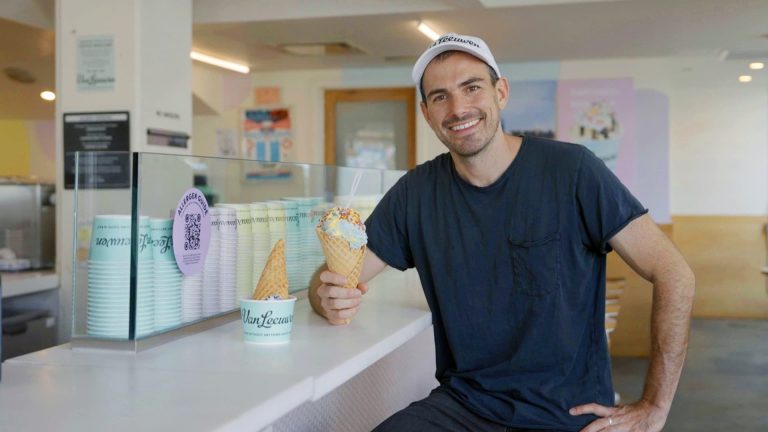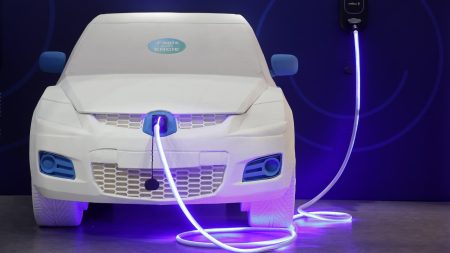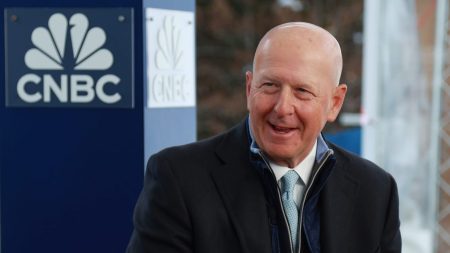Earlier this year, Ben Van Leeuwen had a problem.
The latest Van Leeuwen scoop shop in Washington, D.C. had recently opened for business. But due to unexpectedly high demand, it had run out of ice cream halfway through the weekend.
Ben, who as CEO had long since left the responsibilities of making deliveries behind, was surprised to find himself on a text chain about the new store.
“It’s 11 p.m. on a Saturday night and nobody can deliver that ice cream,” Ben tells CNBC Make It. “And I was like ‘Okay, I’ll do it.'”
Which is how the 39-year-old found himself pulling up to the Van Leeuwen factory in Greenpoint, Brooklyn eight hours later to load a refrigerated truck full of hundreds of tubs of his famous ice cream before making the five hour drive to D.C.
“The plan was to drop off all of this ice cream and drive straight back to New York, because the next day is Monday and I have to work,” he says.
But he arrived to find 100 people already waiting in line and decided to help hand out ice cream for an hour to alleviate the crush. “I ended up scooping till midnight because it was so busy,” he says. “It was so fun.”
Days like that are few and far between for Ben, who since founding Van Leeuwen in 2008 has grown it into a nationwide brand. Van Leeuwen has nearly 50 scoop shops in seven states across the country, and its pints are sold at nearly 10,000 grocery stores including Walmart and Whole Foods.
Here’s how Van Leeuwen went from a lone ice cream truck in SoHo to a multimillion dollar business capable of bringing in upwards of $300,000 a day from its scoop shops alone.
An introduction to ice cream
Ben Van Leeuwen earned money in college by driving a Good Humor ice cream truck.
Van Leeuwen Ice Cream
As a rising college sophomore in need of spending money, Ben came across a newspaper ad offering $500 per week to sell ice cream. Soon, he was behind the wheel of a Good Humor truck slinging Chipwiches, SpongeBob SquarePants ice cream bars and other frozen novelties.
Though he didn’t know it at the time, his experience with Good Humor would play a direct role in shaping the tastes that would later come to define Van Leeuwen.
“That allowed me to save enough money to not go back to college and [instead] travel the world for nine months, which was a super formative experience,” he says.
His gap year travels took him to Southeast Asia as well as all over Europe. His time in Spain, Italy and France was particularly significant in changing his thinking around what food could be.
I was really excited by these places where good food was just a normal thing
“As an American kid who hadn’t really left the country, I was really excited by these places where good food was just a normal thing,” he says.
Once he was back in school, these ideas bounced around Ben’s head without an outlet until one day in 2008 when he came across a Mister Softee ice cream truck — a staple in New York City.
“That’s when subconsciously and consciously everything clicked,” he tells Make It. “I was like ‘Huh, I’m really into good food, but I want that food to be normal and accessible.'”
“New York City was a city then and remains a city now where people respond to and are excited by people who try to do things in the best way possible,” he continues. “So I said ‘Let’s reinvent the ice cream truck.'”
Getting Van Leeuwen off the ground
Ben knew that he wanted to start an ice cream company. But he had one big problem: he had never made ice cream before.
The then 24-year-old retreated to the kitchen of the apartment that he shared with his brother Pete and close friend Laura O’Neill and began a journey of self-education.
He followed a recipe from Michelin star chef Thomas Keller’s “Bouchon” to make vanilla ice cream. He found the process easy to follow, and modeled what would become the Van Leeuwen signature style after the simple, high quality recipe.
With a recipe in hand, Ben, Laura and Pete set about creating a business plan. They determined that they would need $250,000 to get their business off the ground. The quarter million would allow them to buy and renovate a truck, find a factory and create a website.
From left: Ben Van Leeuwen, Pete Van Leeuwen and Laura O’Neill.
Van Leeuwen Ice Cream
Despite their best efforts, they were only able to raise a total of $60,000 from 15 friends and family members.
Still, it was enough to buy a pair of used Post Office trucks off of eBay and give them a second life as retrofitted ice cream trucks. They also set aside funds to hire an artist to design the aesthetic that would come to define Van Leeuwen’s brand.
But even though it had a slick look, Van Leeuwen was very much a ramshackle operation when it launched in 2008. Starting the business with only $60,000 forced the founders to do “almost everything.”
Because they didn’t have the funds to build their own ice cream making facility, they had to outsource their production to a small factory in upstate New York. This required them to travel to the factory for each production run to help grind ingredients like nutmeg and cinnamon.
This ice cream would then be delivered to a freezer in the Bronx, at which point Ben would load it into the back of his Subaru Impreza, crank the AC and rush it to the trucks — a process he says “completely destroyed” his car’s suspension.
“For the first 10 years there was no corporate team,” Ben says. “We were the bookkeepers. We were the CFOs, the CMOs, the retail directors. We were also helping build the stores and repair trucks.”
Sweet, sweet success
Ben Van Leeuwen selling ice cream in 2008.
Van Leeuwen Ice Cream
Van Leeuwen Ice Cream was a hit from day one. When Ben, Laura and Pete pulled up to the corner of Greene and Prince in SoHo, customers immediately started lining up at the hand-painted truck.
The crowd caught the attention of a representative from a local Whole Foods, who approached the truck and asked the owners if they did wholesale. Though he had only just started selling scoops hours earlier, Ben said yes.
“We said ‘We’ll do anything that brings in revenue, so yes, we do wholesale,'” Ben says. “And three months later we were on the shelves in Whole Foods.”
Within three hours of opening [our first] shop, we said ‘We are never building another ice cream truck.’
By the end of that first summer, Van Leeuwen had three trucks operating in New York City. Fans couldn’t get enough of flavors like Honeycomb and Sicilian Pistachio, and by 2010 Van Leeuwen hit $1 million in revenue.
The same year, Van Leewen opened its first brick-and-mortar outpost in Greenpoint. It was a decision that would change the trajectory of its business.
“Literally within three hours of opening that shop, we said ‘We are never building another ice cream truck,'” Ben says. “Shops are so much easier. They generate more revenue. The water is on 99.99% of the time. There’s always power and, most importantly, it’s always in the same place.”
Eggs, cream and branding
In 2012, Van Leeuwen was able to bring production to Brooklyn, and in 2017 it embarked on a major aesthetic rebrand which would create the eye-catching look of its colorful pints and help increase sales by a reported 50%.
The money that Van Leeuwen brought in went towards expanding operations and sourcing ingredients from around the world for its artisanal flavors. One thing the brand has never spent money on? Advertising.
“The marketing for the first 10 years was simply serving our product and hoping that word of mouth would build brand awareness,” Ben says.
These days, Van Leeuwen is known for more than its high-end artisanal flavors. It has made waves on social media for limited edition ice creams made in collaboration with brands like Kraft Mac & Cheese and Hidden Valley Ranch.
These flavors help bring more people to the brand, with the idea being that they will then try some of Van Leeuwen’s less adventurous offerings.
Van Leeuwen Ice Cream CEO and co-founder Ben Van Leeuwen at a Williamsburg, Brooklyn scoop shop.
Lauren Shamo and Tasia Jensen | CNBC make It
“From a more tactical, marketing approach, they allow us to very efficiently build brand awareness,” Ben says. “And we hope that not only will they enjoy those really crazy flavors, but they’ll try the vanilla, they’ll try the honeycomb, they’ll try the Earl Gray tea next.”
Van Leeuwen sells around 50,000 pints per day via its wholesale channels, and serves roughly 40,000 customers a day at its scoop shops in the summer.
The brand is bullish about the appetite for its ice cream. By the end of 2023, Van Leeuwen will have opened 18 new scoop shops, including its first international location in Singapore. An additional 25 to 30 openings are planned for next year.
“As long as we’re able to keep our guests happy and continue serving them good ice cream,” he says, “we will continue to grow.”
And if Ben needs to make another emergency ice cream delivery to one of Van Leeuwen’s scoop shops, he’s ready.
“As the CEO, as the founder, I still spend a lot of time in the stores,” he says. “It’s fun. I really like being on my feet. I’m more gratified when I’ve been serving customers all day than sitting in my office all day.”
DON’T MISS: Want to be smarter and more successful with your money, work & life? Sign up for our new newsletter!
Get CNBC’s free Warren Buffett Guide to Investing, which distills the billionaire’s No. 1 best piece of advice for regular investors, do’s and don’ts, and three key investing principles into a clear and simple guidebook.
Read the full article here









